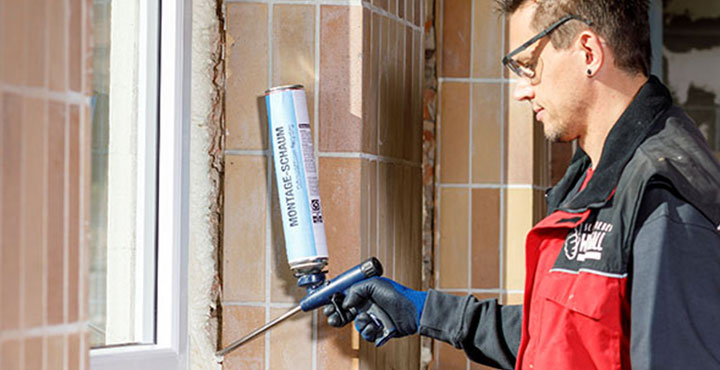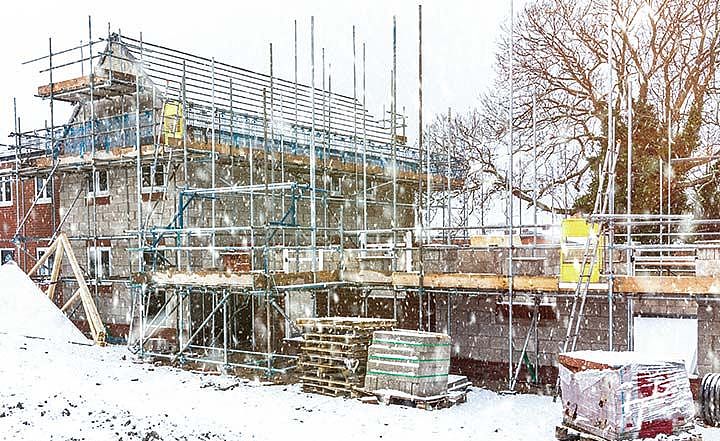
Winter foam – the construction foam for working in cold temperatures
What can you do, if the temperature on the building site drops below 5°C and conventional construction foam no longer works well? The solution for cold weather is winter foam. It will allow you to achieve high-quality results even on winter building sites. And you can insulate and fit windows and doors as usual. Even those hollow spaces that are created, for instance when knocking holes in brick walls or creating openings for pipes, can be filled reliably.
Works up to -10°C.

Winter foam was specifically developed for working at temperatures down to minus 10 degrees Celsius. It differs from foams that are otherwise used during the year in that it remains flexible and hardens well, even at low temperatures. Manufacturers also supply construction foam that can be used down to -20°C for countries with very cold winters.
But why is it that construction foams that have worked so well throughout the year, no longer work as well when it gets colder? There are three main reasons for this.
- Reason 1: not enough humidity
Humidity usually drops with the temperature. In the case of a 1C foam (>>> link 1C foam), the hardening time is longer because the foam requires moisture to harden. The less moisture available, the longer the hardening process. In turn, this could lead to a more coarse foam structure and impaired insulating values. For this reason, there are special formulas available that do not even require additional moistening.
- Reason 2: the chemical reactions are slower in the cold.
Generally, chemical reactions tend to slow down as the temperature drops. The foam does not harden as well. Also, it can become brittle and crumbly, and form a powder-like foam structure on the surface.
In contrast, winter foams are optimised for typical winter weather conditions and retain their properties in the cold.
- Reason 3: the honey effect
If you work with construction foam in the winter, you will probably first notice that less foam comes out of the can when it is cold. This is because the fluid PU polymer in the can acts like honey when cold. The colder it gets, the tougher the compound becomes. This is why it can no longer exit the can valve as easily. Therefore, the can temperature should be at least 5 °C.
Tip: Always check the temperature even of winter foam cans
You should also bear this last point in mind when using winter foam. Even winter foam cans should have a temperature of at least 5°C when they are used. Otherwise, the fluid foam in the can will become too viscous and does not exit the valve properly.
Tip: This is what you can do, if your construction foam can is too cold
If you notice that your cans are too cold, you can warm them carefully, for instance by placing them into warm water; however, always be extremely careful to ensure that the compressed gas in the can does not expand too quickly. There is a risk of explosion, if the can heats up too quickly. Never place the construction foam can in hot water (above 50 °C) or heat with a flame!
When hard, construction foam is resistant to sub-zero temperatures

The question remains as to whether ‘normal’ construction foam insulates as well as winter foam. The answer is a resounding Yes! Once construction foam has hardened, the cold no longer has any effect on it. It is resistant to cold and temperatures of down to - 40°C. And its fine cell structure ensures that the cold stays outside. This also applies for ‘normal’ construction foam that is used in the summer.

![[Translate to Englisch:] Brunnenschaum für wasserdichte Verklebungen [Translate to Englisch:] Brunnenschaum für wasserdichte Verklebungen](/fileadmin/PU-Schaum-Center/PU-Schaumarten/img_PU-Schaumarten_Brunnenschaum.png)
![[Translate to Englisch:] PU-Schaum richtig verarbeiten [Translate to Englisch:] PU-Schaum richtig verarbeiten](/fileadmin/PU-Schaum-Center/PU-Schaum_in_der_Praxis/img_PU-Schaum_richtig_verarbeiten.jpg)
![[Translate to Englisch:] 1 K Schaum [Translate to Englisch:] 1 K Schaum](/fileadmin/PU-Schaum-Center/PU-Schaumarten/img_PU-Schaumarten_1-K-PU-Schaum.png)

